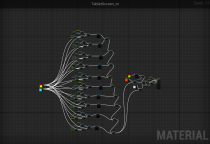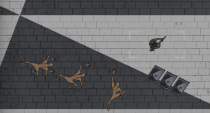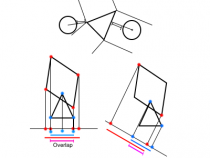Author Archives: Malcolm Yllenius

Making objects in blueprints
During the end of the production our game map was pretty empty. To add variation and lighting to the scene our graphical artists made a couple of assets to clutter the scene with. To make them more versatile I worked on them a bit in blueprints.
I made lamps that changes the emissive amount on the material together with the light sources. The pictured work light can also have it’s head mount adjusted so you can angle the lights. I made […]

Making objects in blueprints
During the end of the production our game map was pretty empty. To add variation and lighting to the scene our graphical artists made a couple of assets to clutter the scene with. To make them more versatile I worked on them a bit in blueprints.
I made lamps that changes the emissive amount on the material together with the light sources. The pictured work light can also have it’s head mount adjusted so you can angle the lights. I made […]

Dynamic Time of Day
In the game you’re supposed to find survivors buried under the rubble of a bombed city and then dig them up. In order to meet deadlines, the game was designed with this feature abstracted to a press of a button and an ensuing cinematic sequence. In order to communicate to the player that time passes during this we decided to have a controllable day and night cycle. In order to save time we decided to use Unreal Engine’s built in […]

Dynamic Time of Day
In the game you’re supposed to find survivors buried under the rubble of a bombed city and then dig them up. In order to meet deadlines, the game was designed with this feature abstracted to a press of a button and an ensuing cinematic sequence. In order to communicate to the player that time passes during this we decided to have a controllable day and night cycle. In order to save time we decided to use Unreal Engine’s built in […]

Visual Aid
For the player to easier see what they are doing we used a couple of visual aids. Early on we used a particle emitter emitting invisible particles that would spawn visible particles when colliding with the ground to show where you are focusing your listening.
This was hard to spot, not very cost effective and hard to control. I had looked in to how to project materials onto surfaces but had somehow missed deferred decals which does exactly that. Setting this […]

Visual Aid
For the player to easier see what they are doing we used a couple of visual aids. Early on we used a particle emitter emitting invisible particles that would spawn visible particles when colliding with the ground to show where you are focusing your listening.
This was hard to spot, not very cost effective and hard to control. I had looked in to how to project materials onto surfaces but had somehow missed deferred decals which does exactly that. Setting this […]

Spectrometer Data
Originally I wanted the spectrometer data to be calculated in real time based on every sound that was played. While not impossible, decompressing audio in real time to do this would be inefficient. My next idea was to extract the spectrometer data externally and parse it in to the game. This would probably have been the optimal solution, but when talking to our tutor he advised against it and told us to fake it. And fake it I did.
So what […]

Spectrometer Data
Originally I wanted the spectrometer data to be calculated in real time based on every sound that was played. While not impossible, decompressing audio in real time to do this would be inefficient. My next idea was to extract the spectrometer data externally and parse it in to the game. This would probably have been the optimal solution, but when talking to our tutor he advised against it and told us to fake it. And fake it I did.
So what […]

Tablet Material
Our sensor audio output was to be visualized on a tablet screen. For this, I’d need spectrometer data from the audio files that were playing, but before getting a hold of that, I needed some way of visualizing the data. At the time I had not yet worked much with Unreal Engine’s material graph. I have written shaders in both HLSL (high-level shading language) and GLSL (OpenGL Shading Language) so I had a vague idea of what I was getting […]

Tablet Material
Our sensor audio output was to be visualized on a tablet screen. For this, I’d need spectrometer data from the audio files that were playing, but before getting a hold of that, I needed some way of visualizing the data. At the time I had not yet worked much with Unreal Engine’s material graph. I have written shaders in both HLSL (high-level shading language) and GLSL (OpenGL Shading Language) so I had a vague idea of what I was getting […]

Detecting Sound
The game’s main mechanic is listening for survivors using triangulation with seismic sensors. To achieve this I created game objects that could be placed out into the world that held a sound file. We wanted the sound to be louder the closer to a sensor it was, rather than just have it play when within a certain radius. To make this work I had to implement a fall-off algorithm. First I tried to just make a simple fall-off where at […]

Detecting Sound
The game’s main mechanic is listening for survivors using triangulation with seismic sensors. To achieve this I created game objects that could be placed out into the world that held a sound file. We wanted the sound to be louder the closer to a sensor it was, rather than just have it play when within a certain radius. To make this work I had to implement a fall-off algorithm. First I tried to just make a simple fall-off where at […]

Geneva Lost Weekly Reflection – Week 10, 2016
Artifact: SHADERS!!!
I must profess something. I am in love. I’ve known about and worked a little bit with shaders before, but not until now that I sit down and actually revisit the area do I remember the beauty that is shaders.
For those of you who do not know, shaders are used for real time post-processing effects in video games (there are other areas of implementation, but it’s mainly purposed for games). Since we’re working with SFML which uses OpenGL, our […]

Geneva Lost Weekly Reflection – Week 10, 2016
Artifact: SHADERS!!!
I must profess something. I am in love. I’ve known about and worked a little bit with shaders before, but not until now that I sit down and actually revisit the area do I remember the beauty that is shaders.
For those of you who do not know, shaders are used for real time post-processing effects in video games (there are other areas of implementation, but it’s mainly purposed for games). Since we’re working with SFML which uses OpenGL, our […]

Geneva Lost Weekly Reflection – Week 9, 2016
Artifact: Crawlers and spawn points
The crawler, which may be our only enemy in the game (due to “budget cuts”), is supposed to be a fast and annoying enemy that attacks in swarms.
When first implementing the crawler it went straight for the player at a constant speed, dealing damage on contact. To make it more interesting we plan to give it some more dynamic behavior. First thing we changed was to give it a maximum turning speed, so that when running towards […]

Geneva Lost Weekly Reflection – Week 9, 2016
Artifact: Crawlers and spawn points
The crawler, which may be our only enemy in the game (due to “budget cuts”), is supposed to be a fast and annoying enemy that attacks in swarms.
When first implementing the crawler it went straight for the player at a constant speed, dealing damage on contact. To make it more interesting we plan to give it some more dynamic behavior. First thing we changed was to give it a maximum turning speed, so that when running towards […]

Geneva Lost Weekly Reflection – Week 8, 2016
Artifact: Collision
Collision is an important part of every game, but can be very challenging. Some games require only simple collision detection: Tile based games makes due with axis aligned box to box collision detection while many space-shooter type games will only require simple circle collision detection.
Given that our game has free form movement we would need a more advanced type of collision to make sure that the game feels right. This we could either achieve with pixel-perfect collision detection or […]

Geneva Lost Weekly Reflection – Week 8, 2016
Artifact: Collision
Collision is an important part of every game, but can be very challenging. Some games require only simple collision detection: Tile based games makes due with axis aligned box to box collision detection while many space-shooter type games will only require simple circle collision detection.
Given that our game has free form movement we would need a more advanced type of collision to make sure that the game feels right. This we could either achieve with pixel-perfect collision detection or […]

Geneva Lost Weekly Reflection – Week 6, 2016
Artifact: Camera
In our game we wanted the camera to be more than just a static viewport. For us, the camera is an important element to convey information to the player.
Firstly, we wanted the camera to gravitate towards the reticle, giving more vision towards the direction you’re looking at. This in itself is simple enough to implement. A simple mathematical formula for the camera position would be
a + b × f
where a is the position of the player, b is the position of the […]

Geneva Lost Weekly Reflection – Week 6, 2016
Artifact: Camera
In our game we wanted the camera to be more than just a static viewport. For us, the camera is an important element to convey information to the player.
Firstly, we wanted the camera to gravitate towards the reticle, giving more vision towards the direction you’re looking at. This in itself is simple enough to implement. A simple mathematical formula for the camera position would be
a + b × f
where a is the position of the player, b is the position of the […]
